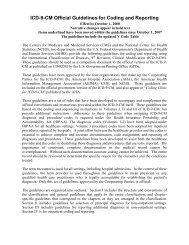Principles of Medical Record Documentation - Office of Compliance ...
Principles of Medical Record Documentation - Office of Compliance ...
Principles of Medical Record Documentation - Office of Compliance ...
Create successful ePaper yourself
Turn your PDF publications into a flip-book with our unique Google optimized e-Paper software.
PROFESSIONAL BILLING COMPLIANCETRAINING PROGRAMMODULE 1PRINCIPLES OF MEDICAL RECORDDOCUMENTATION
<strong>Principles</strong> <strong>of</strong><strong>Medical</strong> <strong>Record</strong> <strong>Documentation</strong>Why Document?<strong>Medical</strong> Reasons• Evaluation, treatment and monitoring• Communication and continuity <strong>of</strong> care• Accurate and timely claims review and payment• Appropriate utilization review and quality <strong>of</strong> care• Collection <strong>of</strong> data for research and teachingLegal Reasons• In medical malpractice cases, may be final piece <strong>of</strong> definitiveevidence.2
<strong>Principles</strong> <strong>of</strong><strong>Medical</strong> <strong>Record</strong> <strong>Documentation</strong><strong>Documentation</strong> <strong>of</strong> each patient encounter should include:• Reason for the encounter and relevant history, physical exam findings,and prior diagnostic test results.• Assessment, clinical impression/diagnosis.• <strong>Medical</strong> plan <strong>of</strong> care.• Date and legible identity <strong>of</strong> the performing provider/observer.Electronic signatures are acceptable – Stamped signatures are not!3
<strong>Principles</strong> <strong>of</strong><strong>Medical</strong> <strong>Record</strong> <strong>Documentation</strong>Other Important Guidelines:• Past and present diagnoses should be accessible to the treating and/orconsulting physician.• Appropriate health risk factors should be identified.• Patient’s progress, response to and changes in treatment and revision<strong>of</strong> diagnosis should be documented.• <strong>Documentation</strong> may be dictated and typed, hand-written or computergenerated.• Use approved abbreviations or standard specialty abbreviations.• Templates may be utilized as long as they meet the intended use.• When referencing another note, always identify by name and date.• <strong>Record</strong> must be complete and legible.4
<strong>Principles</strong> <strong>of</strong><strong>Medical</strong> <strong>Record</strong> <strong>Documentation</strong><strong>Documentation</strong> in the medical record:• Is the only valid support for billing pr<strong>of</strong>essional services.• Must clearly communicate the status <strong>of</strong> the patient -Tell the story <strong>of</strong> thepatient’s visit.• Must support Current Procedure Terminology (CPT) code and InternationalClassification <strong>of</strong> Diseases Clinical Modification (ICD-9 CM)– CPT – listing <strong>of</strong> descriptive terms and identifying codes developed bythe AMA for reporting medical services and procedures performed byphysicians.– ICD-9 CM – diagnosis codes reported on health insurance claim formor billing statement. ** See Evaluation and Management Services Training Module5
<strong>Principles</strong> <strong>of</strong><strong>Medical</strong> <strong>Record</strong> <strong>Documentation</strong>Confidentiality <strong>of</strong> medical record:• Should be fully maintained.• Consistent with the requirements <strong>of</strong> medical ethics and applicable state andfederal confidentiality laws.• Password protect your computer and do not share your passwords withothers.• Use only encrypted flash drives or USB keys to protect the integrity <strong>of</strong>clinical information.6
<strong>Documentation</strong> Assessment – Question 1• True or False:Stamped signatures are not allowed; however, electronic signatures areacceptable.7
<strong>Documentation</strong> Assessment - Answer• The answer is True.Electronic signatures are acceptable but stamped signatures are not.Typically, electronic signatures are generated “on-line” by the physicianand are password protected.8
<strong>Documentation</strong> Assessment – Question 2• True or False:It is acceptable for a provider (MD, NP or PA) to write a postoperativenote prior to the completion <strong>of</strong> the surgical procedure as long as the notesupports the medical necessity.9
<strong>Documentation</strong> Assessment - Answer• The answer is False.It is never acceptable for the provider to include a postoperative note in themedical record before completion <strong>of</strong> the procedure. All entries in recordmust be timely and accurate.10
<strong>Principles</strong> <strong>of</strong><strong>Medical</strong> <strong>Record</strong> <strong>Documentation</strong>Remember!“If is not documented, it is not done; therefore, it is not billable.”“If you can’t read it, it is not documented and/or done.”11
<strong>Documentation</strong> Assessment – Question 3• To ensure that medical record documentation is accurate, thefollowing principles should be followed:a. Notes should be complete and legible.b. <strong>Documentation</strong> should include the date and legible identity <strong>of</strong>the clinician.c. A & B.12
<strong>Documentation</strong> Assessment - Answer• The answer is (c) A&B.The medical record should be complete and legible, and all entries to themedical record should be dated and authenticated.13
References• Centers for Medicare & Medicaid Services – <strong>Documentation</strong> Guidelines forE & M Services: www.cms.hhs.gov/MLNEdWebGuide/25_EMDOC.asp• <strong>Office</strong> <strong>of</strong> Inspector General (OIG) <strong>Compliance</strong> Program for Individual andSmall Group Physician Practices:www.oig.hhs.gov/authorities/docs/physicians.pdf14
















